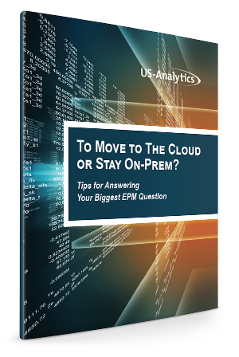With companies looking to reduce their capital expenditures, moving technology to the cloud with a software-as-a-service (SaaS) model makes solid business sense — one way this can be achieved is directly in the finance department with a hosted planning and budgeting technology suite. Oracle Planning and Budgeting Cloud Service (PBCS) provides a pre-packaged, hosted solution for best-in-class financial planning and analysis.
How do you get started with this application and how do you maintain it? Let’s take a look at common questions we answer.
1. What are our deployment options for an Oracle Planning application?
Whether your organization currently operates an Oracle Hyperion Planning environment or you are looking to invest in a new solution entirely, a few flexible options are available: on-premises, Managed Cloud Services, and Planning & Budgeting Cloud Service (PBCS). On-premises reflects a traditional implementation where the organization manages and owns the infrastructure, whereas PBCS is Oracle’s complete cloud offering for planning, and Managed Cloud Services is a hybrid model of the two:
ON-PREMISES
OVERVIEW: Customer manages; Customer owns infrastructure
SOFTWARE INCLUDED: Hyperion Planning, Smart View, Financial Reports, Web Analysis, Predictive Planning; RDMBS licensed separately
HARDWARE ENVIRONMENTS: Customer owned and maintained; Typically Test/Prod or Dev/Test/Prod
MAINTENANCE AND UPGRADES & BACKUPS: Install, upgrade & patching done by customer/consultants
DATA CENTER: N/A — on customer site
SUPPORT: Part of maintenance contract — extra charge
MANAGED CLOUD SERVICES
OVERVIEW: Customer owns license — Oracle MCS or Partner owns licenses on behalf of end use; Partner MCS, Provider owns infrastructure
SOFTWARE INCLUDED: Hyperion Planning, Smart View Financial Reports Web Analysis, Predictive Planning
HARDWARE ENVIRONMENTS: Customer determined; Oracle owned and operated; Typically Test/Prod or Dev/Test/Prod; Charged per environment
MAINTENANCE AND UPGRADES & BACKUPS: Install, upgrade & patching done by customer/partner/Oracle; Included in Managed Cloud Service pricing
DATA CENTER: Customer choice (Oracle hosted or own partner site)
SUPPORT: Part of maintenance contract — extra charge
PBCS
OVERVIEW: Subscription-based; Provider manages; Provider owns infrastructure
SOFTWARE INCLUDED: Hyperion Planning, Smart View, Financial Reports, Predictive Planning, Financial Data Management, Essbase (ASO) Reporting Cubes; RDBMS license included
HARDWARE ENVIRONMENTS: Oracle owned and operated; Test & Production; Two environments included in subscription price
MAINTENANCE AND UPGRADES & BACKUPS: Included in monthly subscription fee per user; Customer can back up on-premises also; Emergency fixes every day, patches every month, enhancements every few months; No installs; Software owned and operated by Oracle
DATA CENTER: Oracle owned or operated; Worldwide data centers
SUPPORT: Included in subscription
2. How do we migrate our on-premises application to the cloud?
If you currently operate an on-premises environment, migrations can be performed from Planning release 11.1.2.1.x. With careful consideration and attention to setup and migrating various artifacts of an environment, the shift to the cloud can be seamless.
3. How are upgrades and system maintenance handled with Oracle PBCS?
With PBCS, you do not own the hardware or maintain the software, so why should you pay for upgrades and system maintenance? Good news — you don’t have to. To alleviate a significant pain point for organizations, upgrades and system maintenance are now included within the PBCS monthly subscription fee. Oracle Cloud Operations routinely implements changes to infrastructure and software to preserve stability, availability, security, performance, and currency of the Oracle Cloud. These changes are performed as part of regular systems maintenance according to a predefined, scheduled service period (typically a one-hour window). Regular systems maintenance is targeted to occur during the statistically lightest utilization period.
In addition, Oracle will apply emergency fixes daily, patches every month, and other enhancements every few months. Organizations should routinely upgrade to the most recent version to have uninterrupted access to the most advanced service. For services that are multi-version, organizations have the flexibility to run the latest available version or the version prior to the latest available version. The process is straightforward and efficient, and does not require additional cost to maintain.







